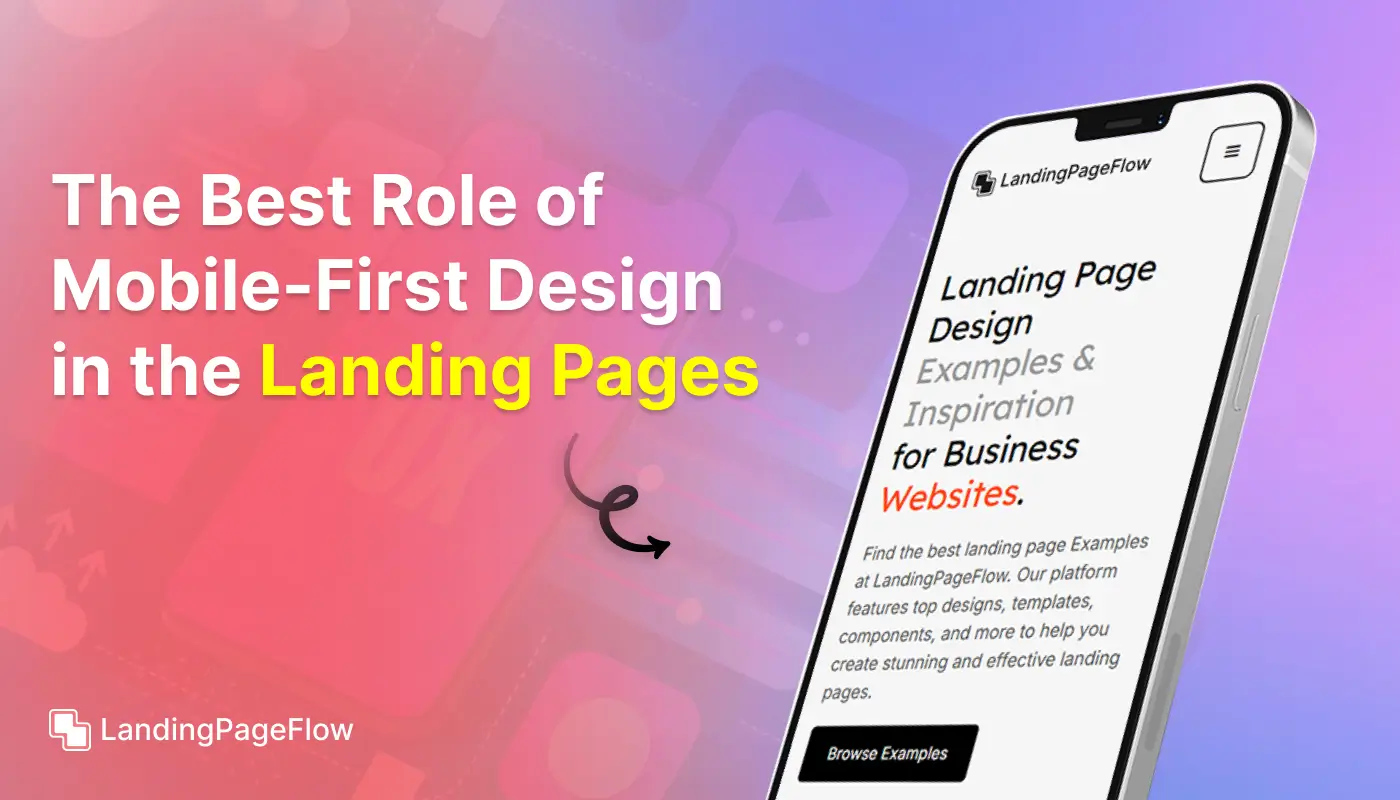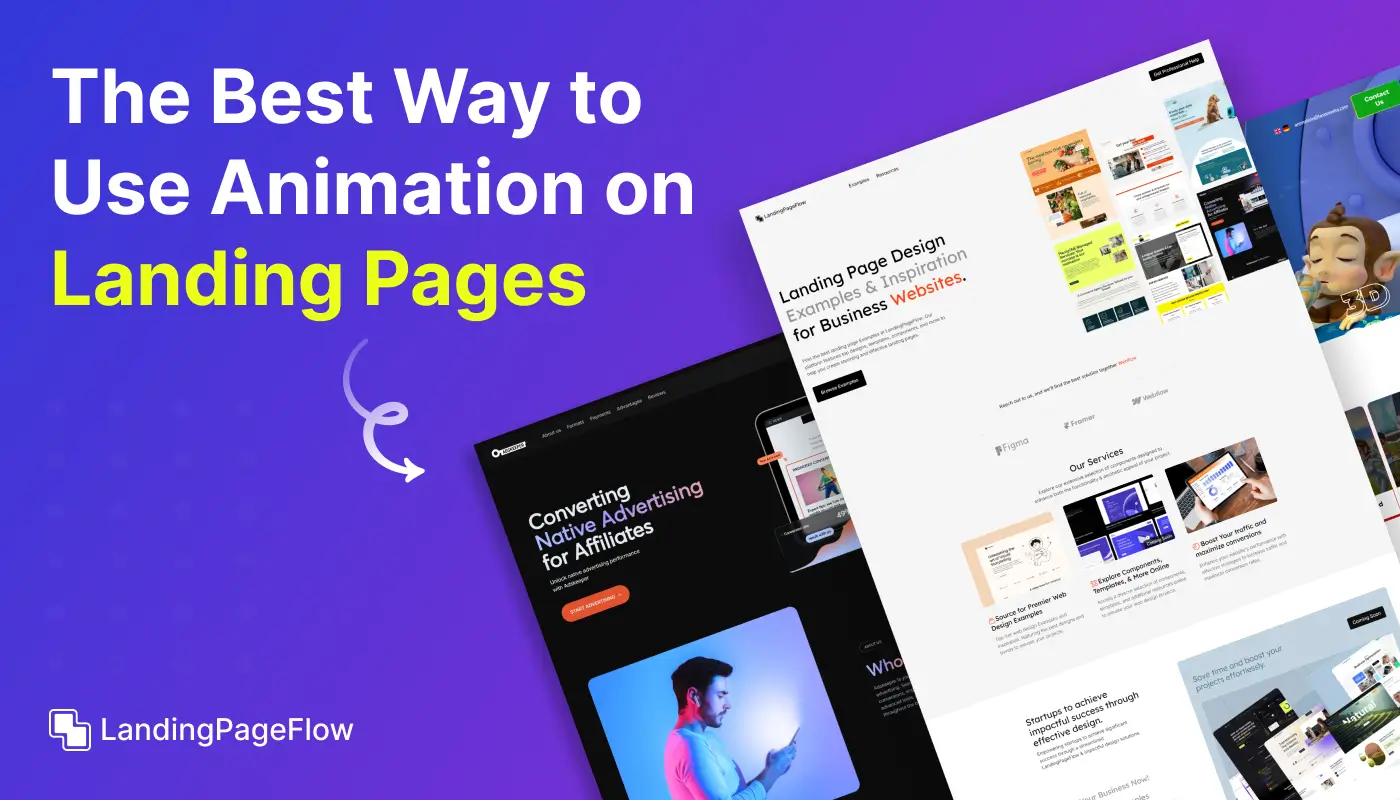Top Landing Page Copywriting Mistakes to Avoid in 2025
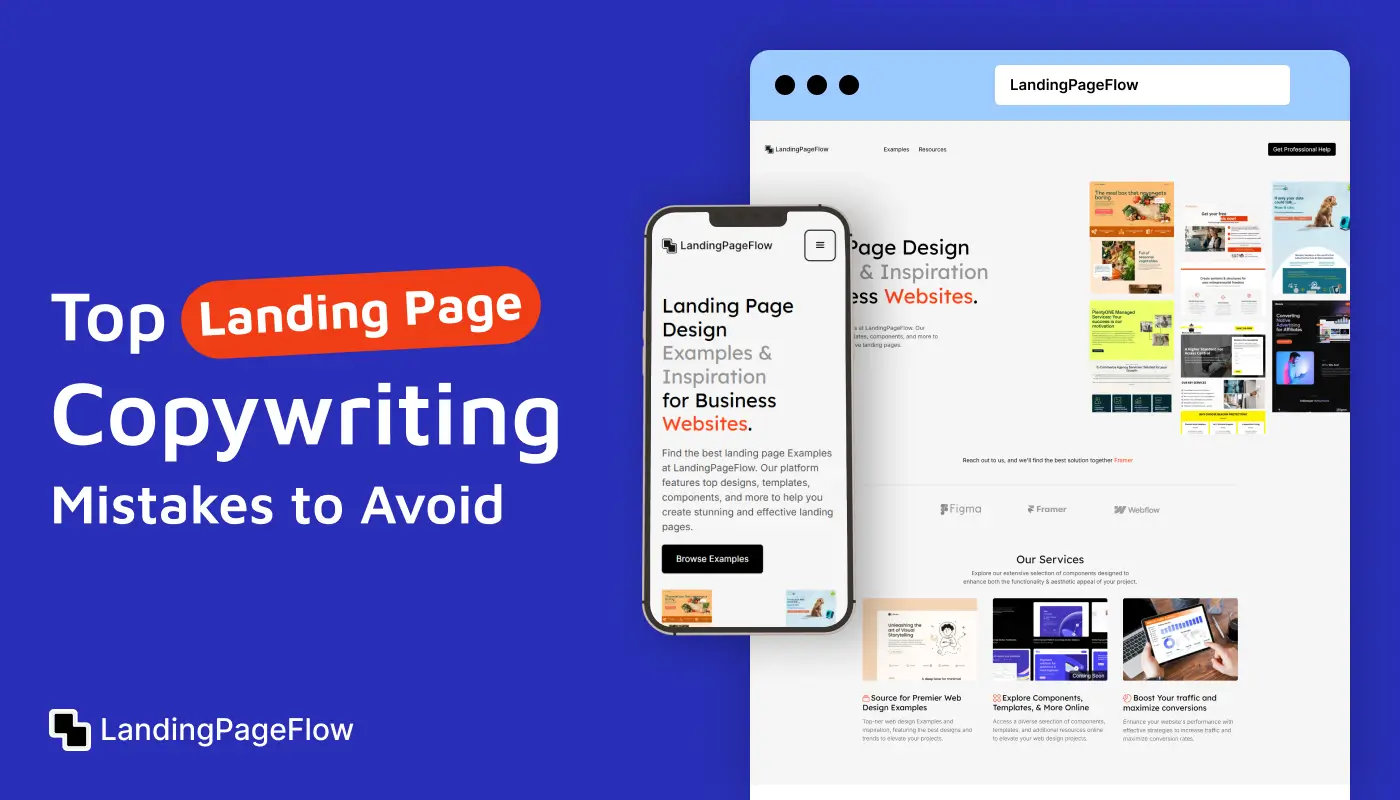
November 11, 2025
Writing compelling and strategic landing page copy in 2025 is no longer optional, and it’s essential to stand out, drive engagement, and improve conversion rates.
As attention spans shrink and competition increases, your message must be clear, persuasive, and aligned with your audience’s needs from the very first sentence.
Yet many businesses still repeat the same copywriting mistakes that silently hurt performance. These include weak or unclear calls-to-action, vague value propositions, inconsistent tone, keyword stuffing, and writing that focuses on features instead of benefits.
Each of these issues can harm your SEO ranking, confuse your users, and lead to lower lead generation or sales.
Strong landing page copy is not just about sounding good; it’s about guiding your visitors toward action. It shapes your brand voice, builds trust quickly, and drives behavior that supports your business goals.
In this guide, we’ll explore the most common and costly landing page copywriting mistakes marketers make in 2025.
You’ll learn how to avoid these pitfalls, what strategies work best today, and how to optimize your content for both user experience and search engines.
"Ready to transform your landing page into a high-performing lead machine?
Let’s craft your next big win. Book your free 15-minute copy review today."
Table of Contents
- What is Copywriting?
- Why Landing Page Copywriting Matters in 2025?
- Pros & Cons of Copywriting
- Top Copywriting Mistakes to Avoid in Landing Pages
- How to Test and Optimize Your Landing Page Copy?
1. What is Copywriting?
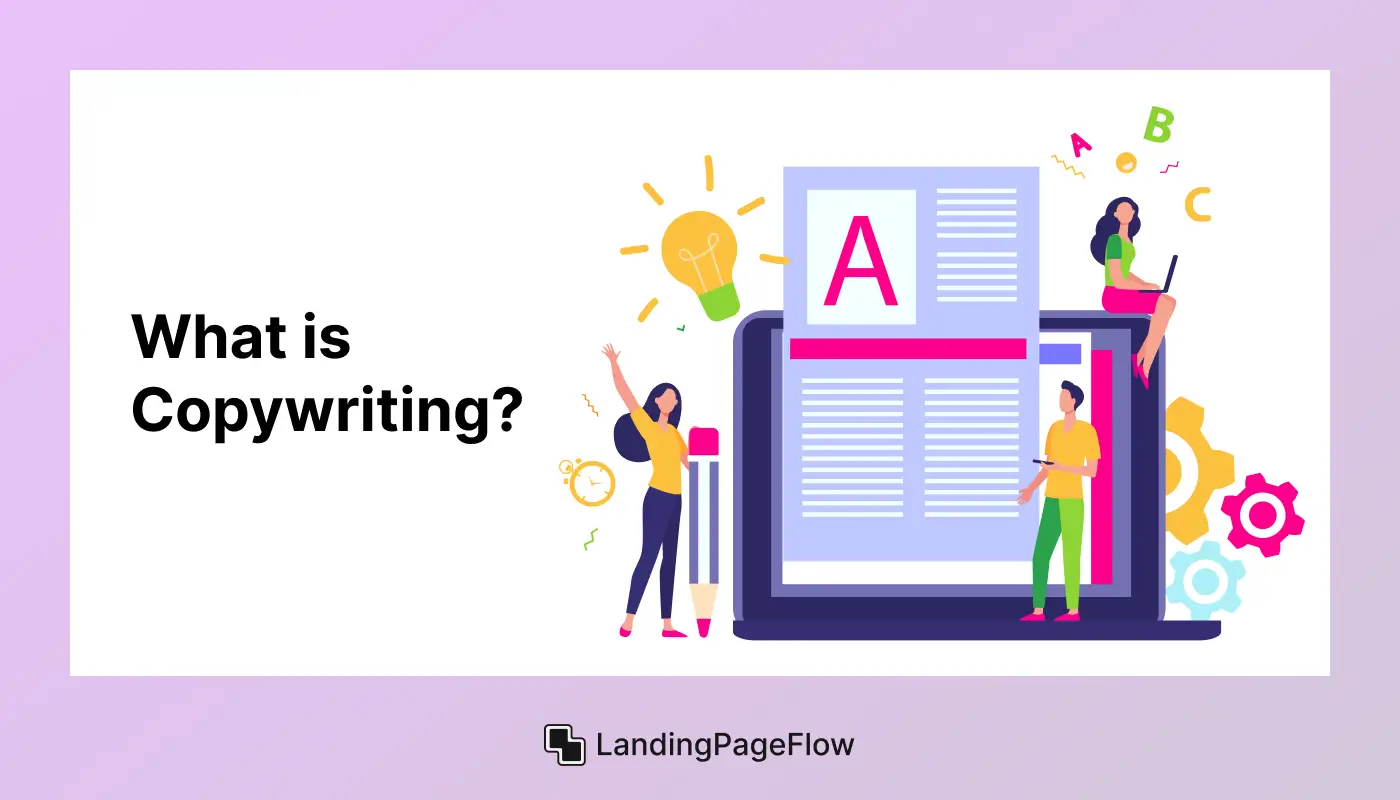
Copywriting is the process of writing persuasive and strategic text designed to prompt users to take action, such as clicking a button, signing up for a service, or making a purchase. It’s a core part of digital marketing, and it directly impacts how well your landing pages, ads, websites, and emails perform.
Unlike general content writing, copywriting focuses on conversions. Every word is chosen to grab attention, highlight value, and guide visitors through a seamless decision-making process.
Great copy addresses pain points, answers objections, and creates urgency, while staying aligned with your brand tone and audience needs.
In 2025, successful website copywriting blends SEO best practices with emotional storytelling, clear CTAs, and a mobile-first structure. It not only improves Google search visibility but also boosts user engagement and conversion rates.
If you're building a high-performing landing page, mastering copywriting techniques is key to turning passive visitors into loyal customers.
2. Why Landing Page Copywriting Matters in 2025?
Creating a high-converting landing page in 2025 goes beyond sharp visuals and sleek layouts. To truly engage your audience and boost performance, you need strategic, persuasive copy that leads users to take meaningful action.
Copy is often the first and only chance to make a connection. Instead of relying solely on design, successful landing pages focus on messaging that builds trust, answers objections, and communicates value instantly. When done well, landing page copywriting helps improve everything from SEO rankings to conversion rates.
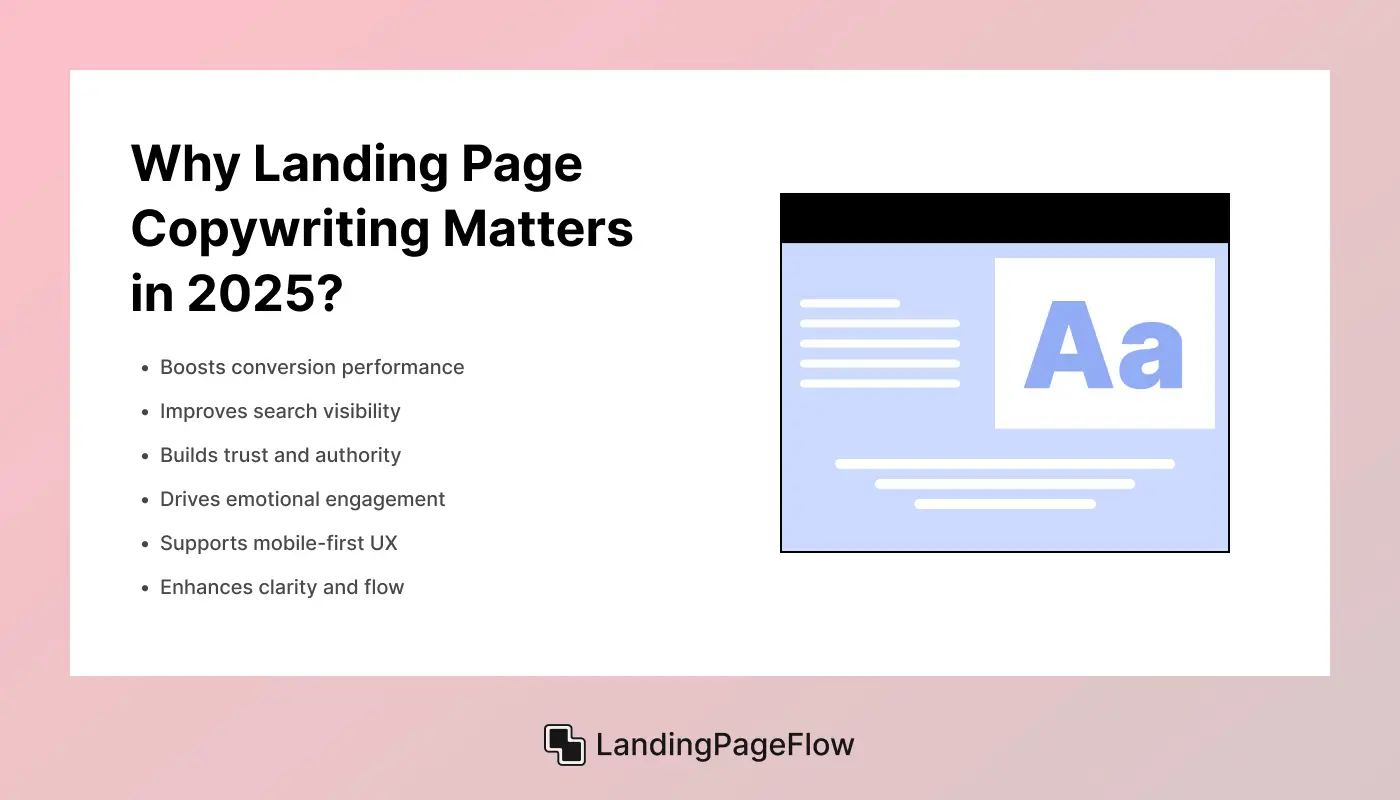
Here’s why great copy matters now more than ever:
1. Boosts conversion performance
Turn visitors into leads or customers through compelling value-driven messaging that aligns with user intent.
2. Improves search visibility
Well-written, keyword-rich content helps landing pages rank higher in Google search results, increasing organic traffic.
3. Builds trust and authority
Clear, benefit-focused writing reassures visitors and strengthens your brand's credibility within seconds.
4. Drives emotional engagement
Strong headlines and focused storytelling can create urgency, excitement, or connection that motivates users to act.
5. Supports mobile-first UX
Short, impactful copy fits smaller screens and ensures messaging is just as effective on mobile devices.
6. Enhances clarity and flow
Good copy breaks complex ideas into easy-to-follow messages, improving readability and page structure.
3. Pros & Cons of Copywriting
Pros:
✔ Boosts Conversion Rates: Effective copy turns visitors into leads or customers by guiding them through persuasive messaging.
✔ Improves SEO Rankings: Keyword-rich, well-structured copy enhances your website's visibility in Google search results.
✔ Builds Brand Voice: Strong copy reinforces your identity, tone, and values across all digital touchpoints.
✔ Increases User Engagement: Clear, emotionally driven copy keeps users reading, scrolling, and interacting with your page.
✔ Supports Sales Funnels: Helps move users from awareness to action using proven psychological and storytelling techniques.
Cons:
❌ Time-Consuming: Writing quality landing page copy takes research, testing, and iteration to get right.
❌ Risk of Generic Messaging: Poorly written or AI-generated content can feel robotic or fail to connect with real audiences.
❌ Dependent on Audience Insights: Without a clear understanding of user needs, even great writing may miss the mark.
❌ Not a One-Time Task: Copy needs regular updates to reflect changing trends, user behavior, and SEO shifts.
❌ Requires Skill or Expertise: High-quality conversion copywriting often demands professional input or training.
4. Top Copywriting Mistakes to Avoid in Landing Pages
1. Slow Load Time
Many brands still underestimate how heavily page speed impacts conversions and overall landing page performance in 2025. It’s not just about technical SEO, but it’s about user experience, bounce rates, and trust.
You might hear thoughts like:
“Users will wait a few extra seconds, it’s no big deal,” or
“Our design looks amazing, so speed doesn’t matter.”
Who told you speed doesn’t affect results? In reality, even a 1-second delay in load time can drastically lower conversions and hurt your Core Web Vitals score.
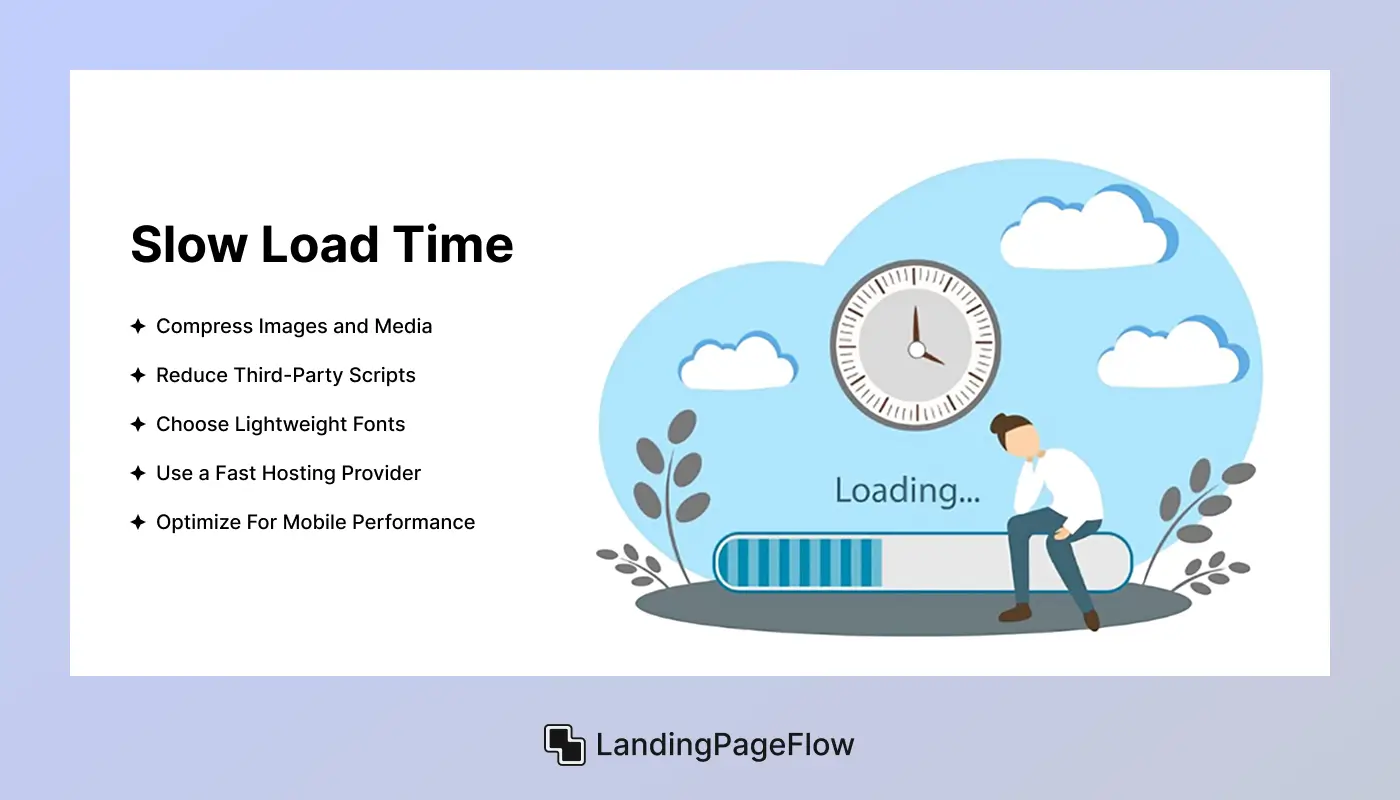
How to Fix This Landing Page Mistake
To correct the mistake of ignoring slow load speeds, you need to treat speed as a design priority, not just a backend issue.
Here’s how to optimize for performance without compromising design:
1. Compress Images and Media
Use next-gen formats like WebP, lazy-load videos, and minimize file sizes to improve load times instantly.
2. Reduce Third-Party Scripts
Too many plugins or tracking codes slow down rendering. Only keep essential integrations and defer non-critical ones.
3. Choose Lightweight Fonts
Stick to 1–2 optimized Google Fonts and limit font weights to avoid bloating your load.
4. Use a Fast Hosting Provider
Your server response time affects TTFB (Time to First Byte). Opt for CDNs and speed-first hosting solutions.
5. Optimize For Mobile Performance
Test on real devices and networks, especially 3G or low-speed conditions, to ensure your mobile load time stays under 3 seconds.
2. Overloaded Interface
In 2025, many landing pages still fall into the trap of trying to do everything at once, resulting in a cluttered, confusing, and overwhelming user experience.
You might hear things like:
“We want to showcase everything above the fold,” or
“Let’s add more CTAs so users have multiple options.”
Who told you more content equals better results? In reality, an overloaded interface dilutes your core message, distracts the user, and damages conversion performance. A busy layout can cause decision fatigue, slower load times, and poor mobile usability.
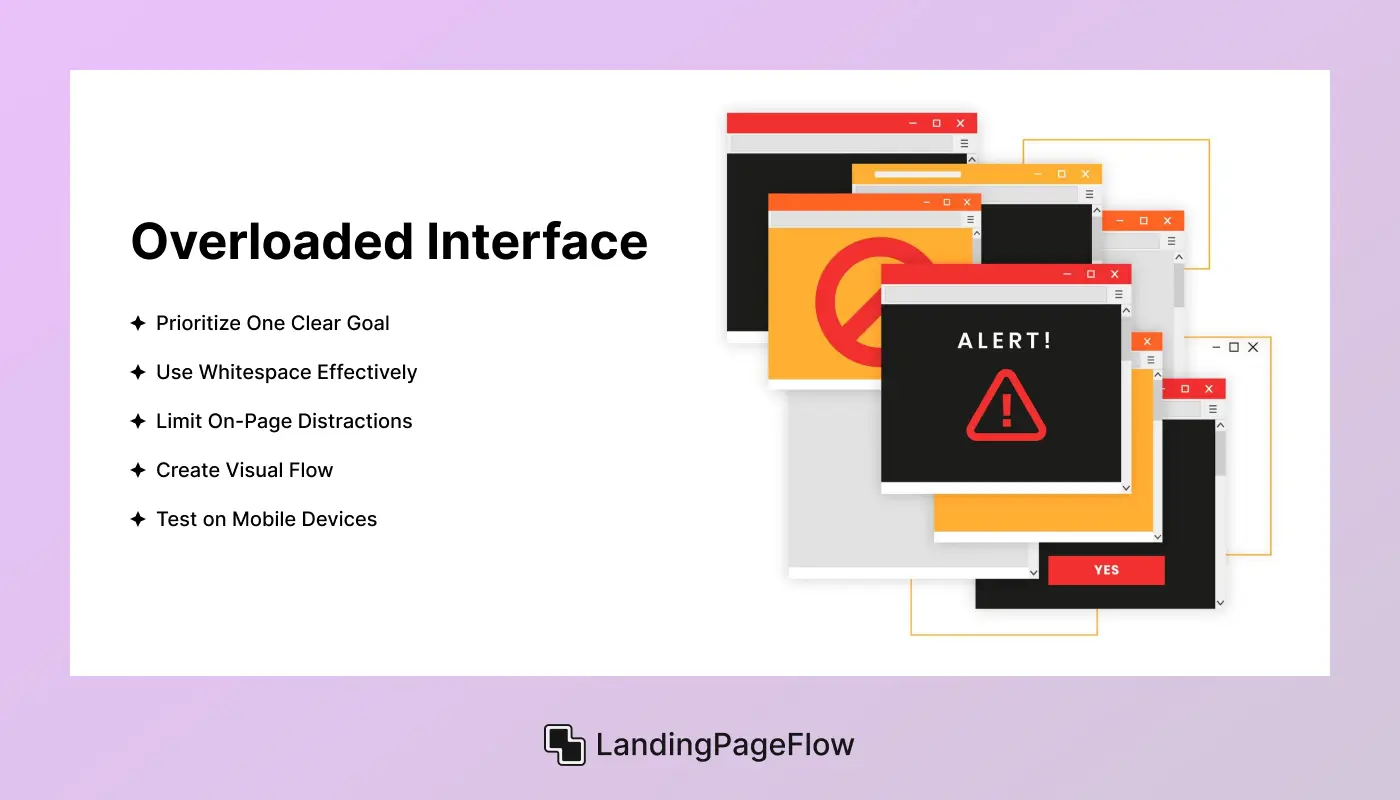
How to Fix This Landing Page Mistake
To improve clarity and usability, simplify your layout and focus on what matters most to the user.
Here's how to reduce interface overload while boosting performance:
1. Prioritize One Clear Goal
Every landing page should have one primary CTA. Make it prominent and support it with clean, intentional content.
2. Use Whitespace Effectively
Strategic spacing increases focus, reduces cognitive load, and improves visual hierarchy for better scanning.
3. Limit On-Page Distractions
Avoid autoplay videos, pop-ups, or multiple competing banners that pull attention from your main action.
4. Create Visual Flow
Design your layout to guide the user naturally, from headline to value proposition to CTA - using contrast and directional cues.
5. Test on Mobile Devices
What looks fine on a desktop may be overwhelming on smaller screens. Streamline content blocks and stack elements for better mobile flow.
3. SEO Not Prioritized
Despite being in 2025, many brands still treat SEO as an afterthought in their landing page strategy. This leads to missed opportunities for organic visibility, traffic growth, and long-term performance.
You might hear things like:
“We’re running paid ads, so SEO isn’t important,” or
“Our page looks great - why worry about keywords and metadata?”
Who told you that designing alone will drive traffic? The truth is, even the most visually appealing landing page won’t convert if no one can find it. Search engine optimization is essential for improving Google rankings, increasing discoverability, and building sustainable traffic pipelines.
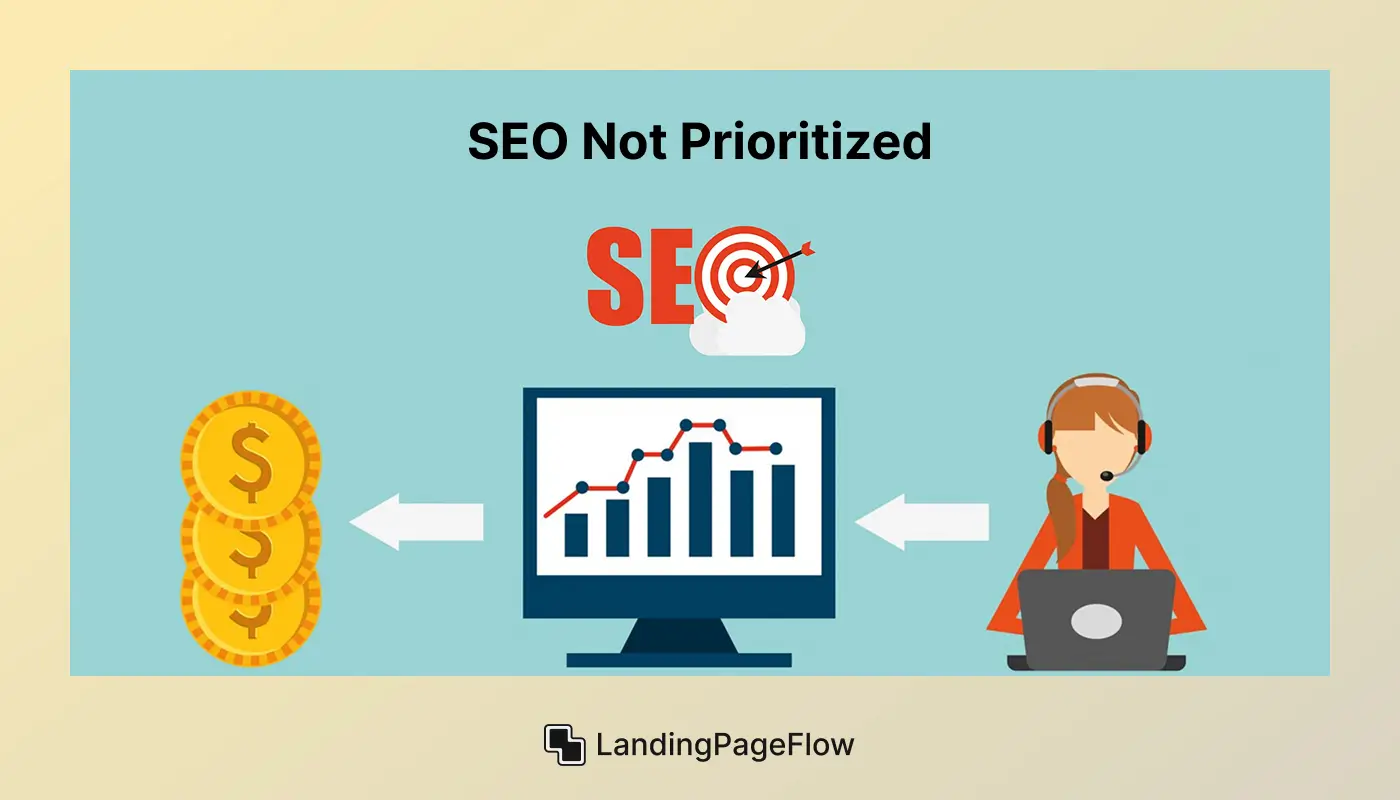
How to Fix This Landing Page Mistake
To fix the mistake of neglecting SEO, you need to make it part of your landing page planning, not an afterthought.
Here’s how to align your copy and structure with SEO best practices:
1. Use Relevant Keywords Strategically
Naturally include keywords in your headings, subheadings, and paragraph copy without stuffing. Align content with search intent.
2. Write Unique Meta Titles & Descriptions
Avoid duplicates. Craft compelling, keyword-rich meta tags that increase click-throughs from search engine results pages.
3. Optimize Heading Structure (H1–H3)
Use a clear HTML hierarchy. Your main topic should be in the H1, with supporting points in H2s and H3s.
4. Improve Page Load Speed
Fast-loading pages rank higher. Compress assets, minimize scripts, and use performance-first hosting.
5. Include Alt Text For Images
Add descriptive alt tags to all visual elements to enhance accessibility and improve image SEO.
4. Confusing CTAs
A common mistake in landing page design is placing too many CTAs, or using unclear ones, that leave users guessing. In 2025, call-to-action clarity is more important than ever for driving conversions.
You’ll often hear things like:
“Let’s give users more options,” or
“Multiple CTAs increase chances of interaction.”
Who told you more CTAs lead to better results? The truth is, confusing or inconsistent CTAs disrupt the user journey, increase bounce rates, and hurt overall conversion performance. If users aren’t sure what to do next, they often leave without taking any action at all.
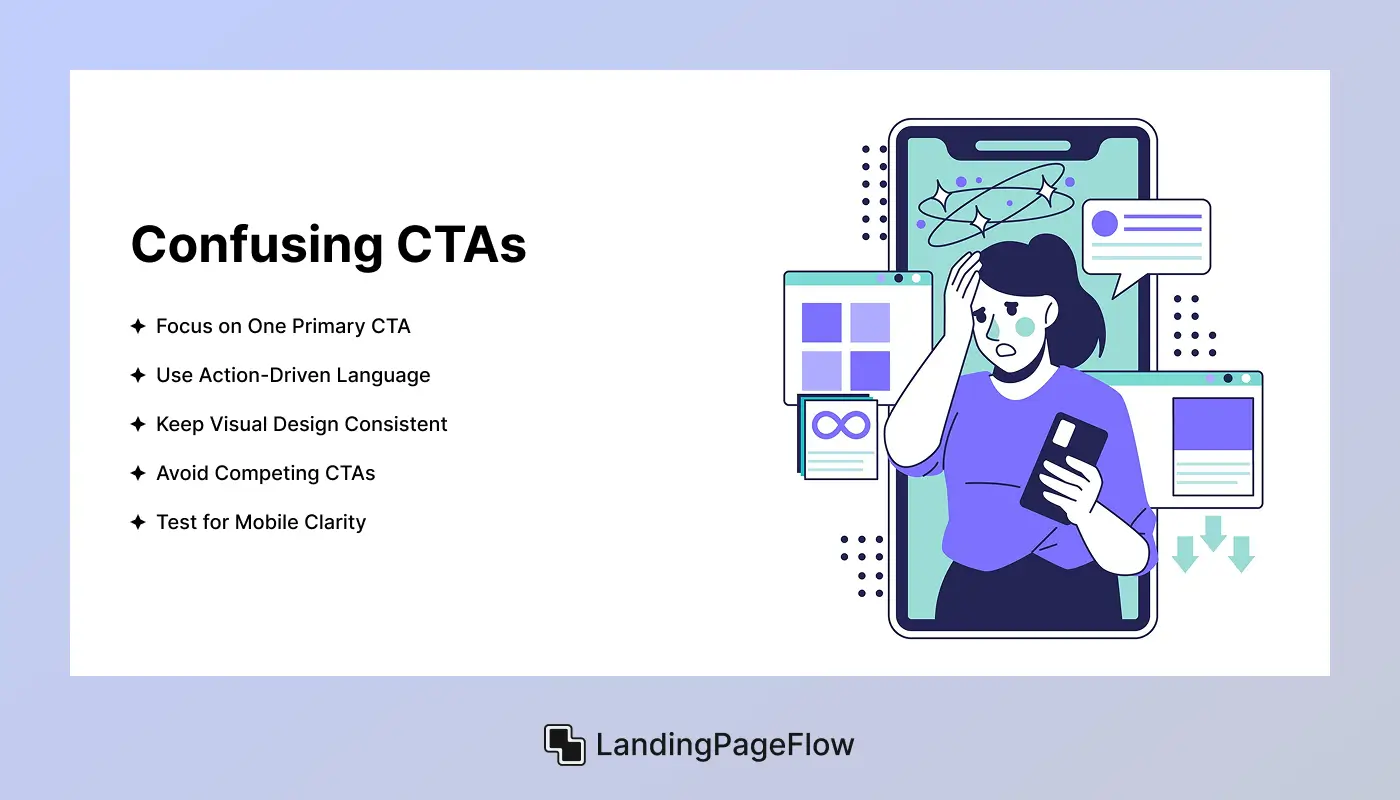
How to Fix This Landing Page Mistake
The solution isn’t just reducing CTA count, and it’s about creating a single, clear path to action.
Here’s how to optimize your CTA placement and language for clarity and results:
1. Focus on One Primary CTA
Choose a single main goal (e.g., “Get Started,” “Download Now”) and support it throughout the page.
2. Use Action-Driven Language
Replace vague words like “Submit” with clear, benefit-oriented phrases like “Claim Your Free Trial” or “Book My Demo.”
3. Keep Visual Design Consistent
All CTA buttons should follow the same color, shape, and style so users recognize them instantly.
4. Avoid Competing CTAs
Don’t place “Buy Now” next to “Learn More” unless they serve different user intents and flows.
5. Test for Mobile Clarity
Make sure CTAs are visible, tappable, and not buried in long sections, is especially on smaller screens.
5. Bad or Irrelevant Content
In 2025, nothing pushes users away faster than landing pages filled with generic, off-topic, or shallow content. Visitors expect relevance and value the moment they land - anything less damages credibility and kills conversions.
You’ve probably heard:
“Let’s just fill the space with something,” or
“Content isn’t that important if the design looks good.”
Who told you filler content is enough? The reality is, a poor or irrelevant copy fails to match user intent, weakens SEO rankings, and makes your brand look untrustworthy. Users won’t convert if your content doesn’t answer their questions or align with their goals.
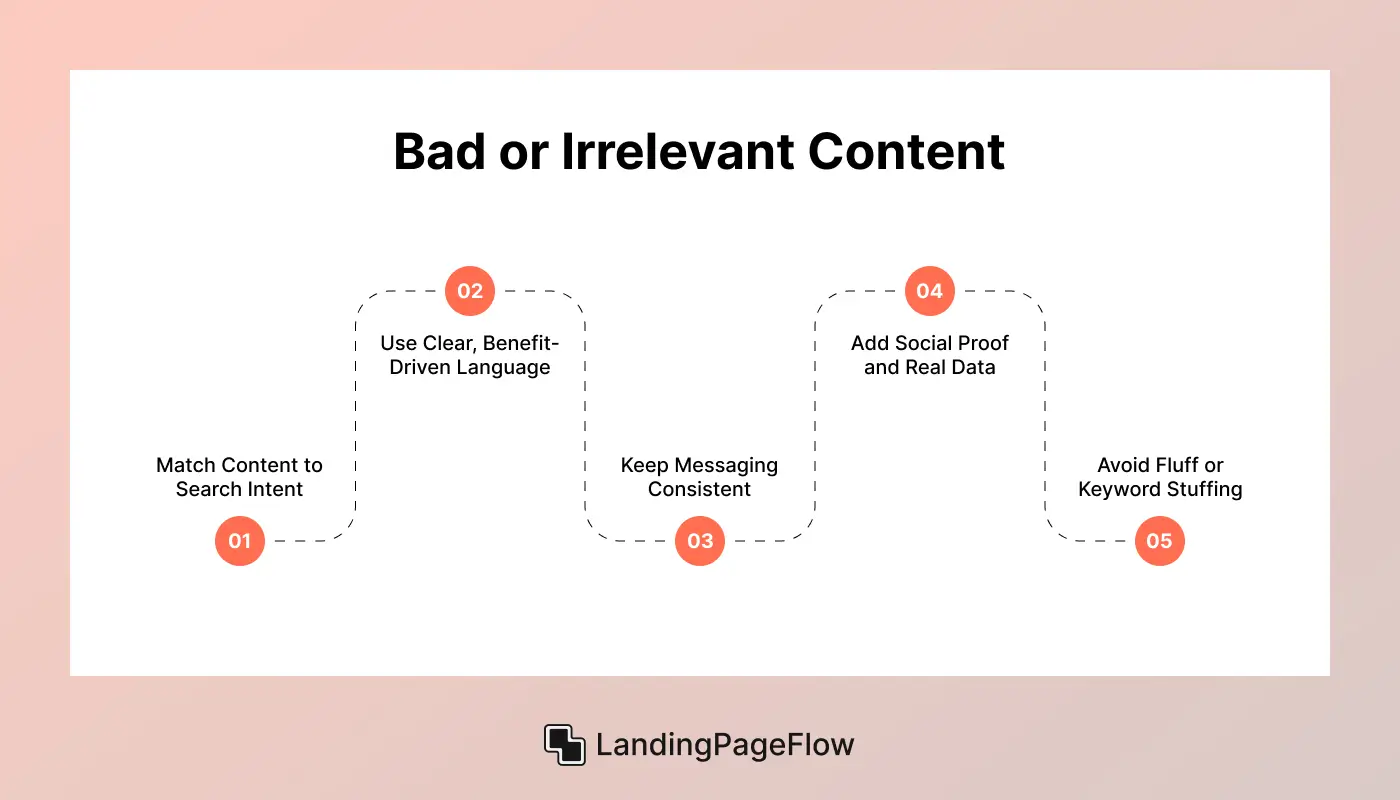
How to Fix This Landing Page Mistake
Fixing irrelevant content starts by understanding your audience and tailoring every word to their needs.
Here’s how to elevate your copy for performance:
1. Match Content to Search Intent
Every section should directly support what users are looking for - address their pain points, desires, or questions.
2. Use Clear, Benefit-Driven Language
Explain what the user gains, not just what your product does. Speak in outcomes, not features alone.
3. Keep Messaging Consistent
Align your content tone, offer, and visuals with your brand identity and user expectations.
4. Add Social Proof and Real Data
Boost credibility with testimonials, stats, or trust badges that reinforce the message.
5. Avoid Fluff or Keyword Stuffing
Only include what adds value. SEO-friendly content should still feel human, relevant, and purposeful.
6. Skipping A/B Optimization
In 2025, many brands still publish landing pages and forget about them. Without A/B testing, you're leaving performance gains on the table and relying only on assumptions, not evidence.
You might hear things like:
“We already like the design,” or
“We don’t have time to run experiments.”
Who told you the first version is the best version? The truth is, skipping A/B optimization keeps you from discovering what truly works. Even small changes in layout, copy, or button design can dramatically improve conversion rates, engagement, and user flow.
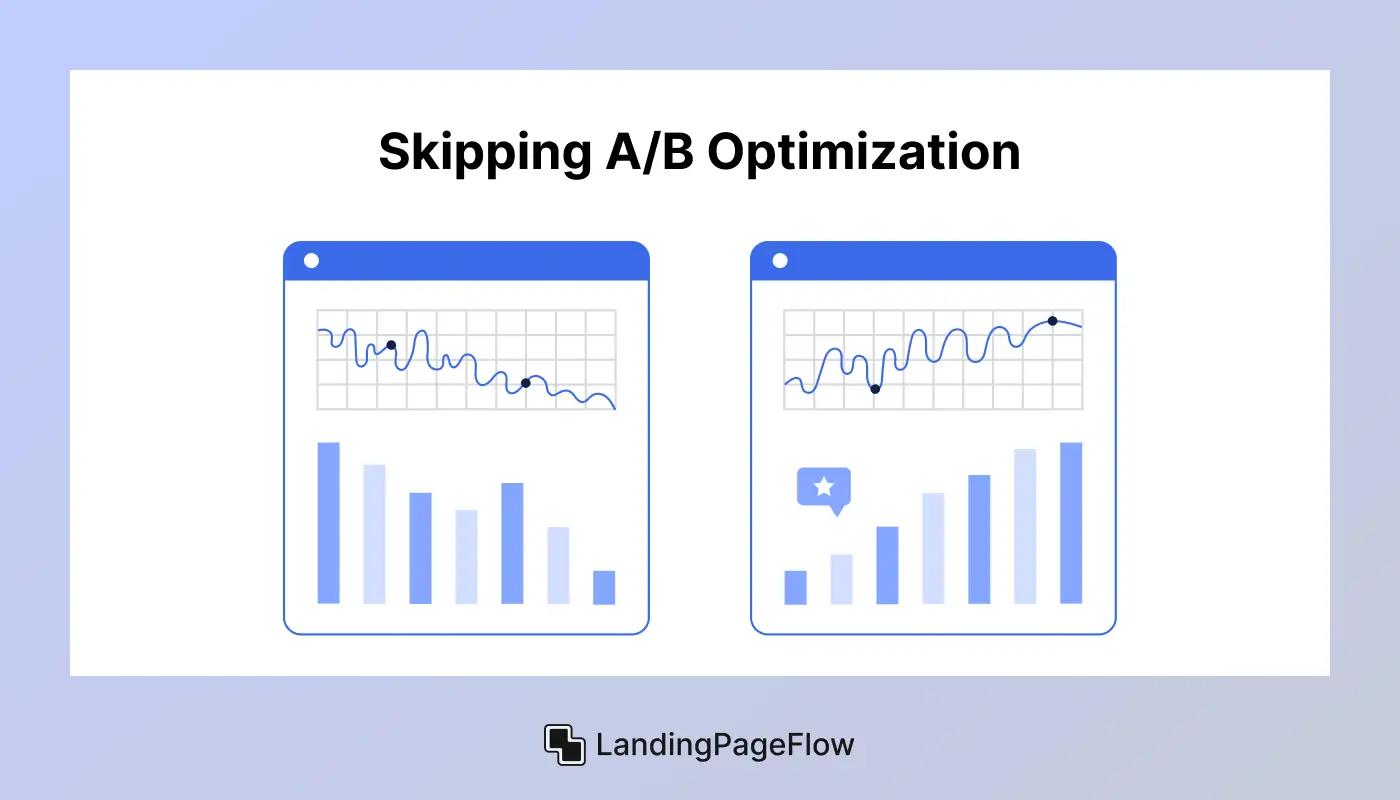
How to Fix This Landing Page Mistake
Integrate testing into your process early and treat it as an ongoing tool for growth.
Here's how to make landing page optimization part of your strategy:
1. Start with Simple Changes
Test one variable at a time, such as the headline, CTA text, or form length, to identify what improves performance.
2. Use Accessible Tools
Platforms like Webflow, Unbounce, and Google Optimize make it easy to launch and measure A/B tests without coding.
3. Track the Right Metrics
Monitor key indicators such as click-through rates, form completions, and time on page to understand user behavior.
4. Test Across Devices
What performs well on a desktop may fail on mobile. Ensure you're testing layout variations for responsiveness and usability.
5. Refine Based on Real Data
Use performance insights to iterate, not assumptions. Let the results guide your content and design decisions.
7. Real User Feedback
Too often, landing pages are built based solely on team assumptions or internal reviews. Failing to include real user feedback results in pages that look good in theory but miss the mark in practice.
You might hear things like:
“Our team already tested it,” or
“No one’s complained, so it must be working.”
Who told you silence means success? In reality, ignoring user insights leads to missed chances for improving conversion rate, page clarity, and user experience. What your audience thinks, feels, and struggles with can reveal blind spots that analytics alone can’t uncover.
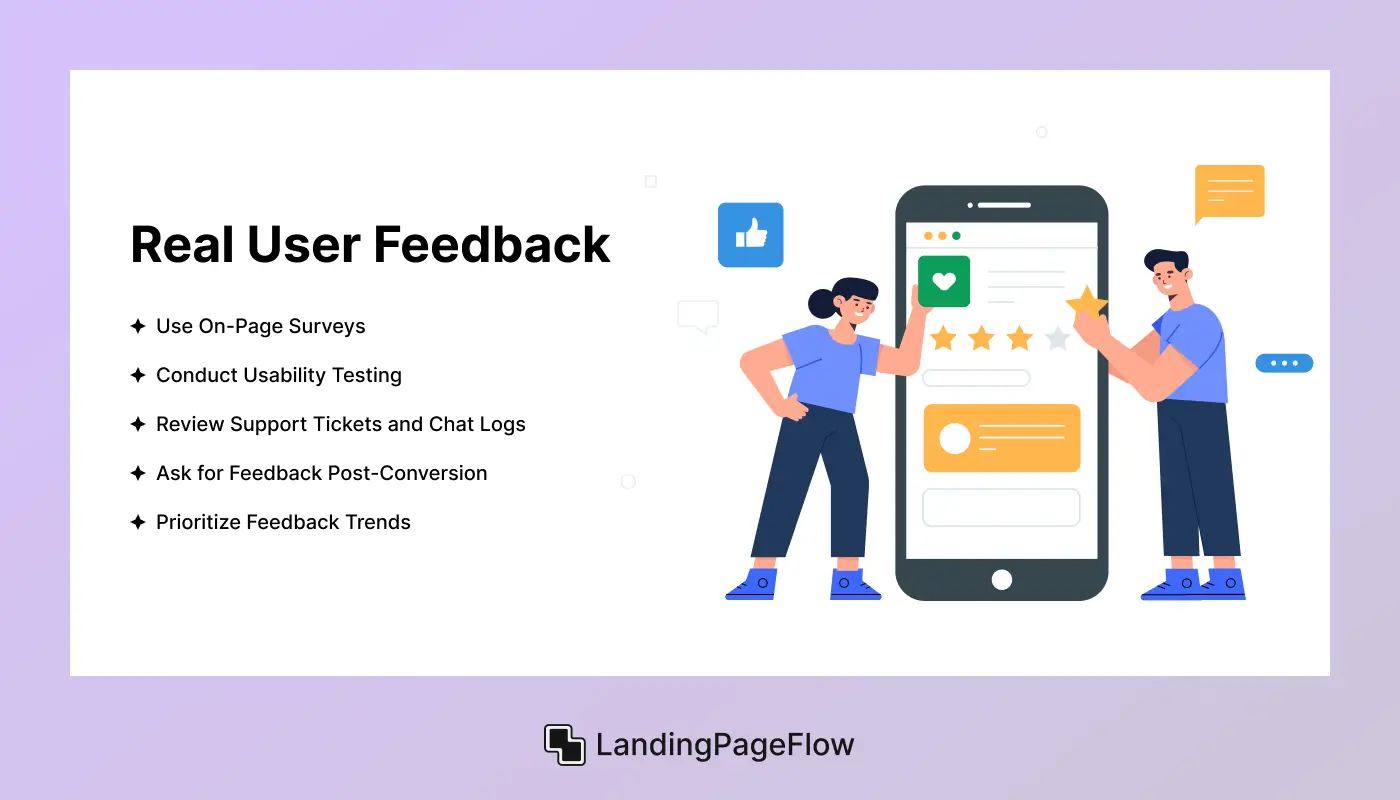
How to Fix This Landing Page Mistake
Listening to your actual users is the fastest path to meaningful improvements.
Here’s how to bring user-driven feedback into your optimization process:
1. Use On-Page Surveys
Simple exit-intent or scroll-triggered questions like “What stopped you from converting today?” can uncover friction points.
2. Conduct Usability Testing
Watch real users navigate your page through tools like Hotjar, Maze, or UserTesting. Look for moments of confusion or drop-off.
3. Review Support Tickets and Chat Logs
Customer service interactions often reveal unclear messaging, missing info, or broken flows that need attention.
4. Ask for Feedback Post-Conversion
After a signup or download, ask users what made them act. This helps identify persuasive elements worth keeping.
5. Prioritize Feedback Trends
Don't get distracted by one-off comments. Focus on consistent patterns that suggest widespread issues or opportunities.
8. Forgetting the CTA
A landing page without a clear call-to-action (CTA) is like a sales pitch with no close. In 2025, missing or weak CTAs result in lost conversions, wasted traffic, and a confused audience that doesn’t know what to do next.
You might hear things like:
“The design speaks for itself,” or
“We’ll add the CTA later.”
Who told you users will act without direction? The truth is, forgetting the CTA leaves visitors stranded. Even the most visually stunning page fails if it doesn’t lead users toward a defined next step, whether that’s signing up, downloading, or making a purchase.
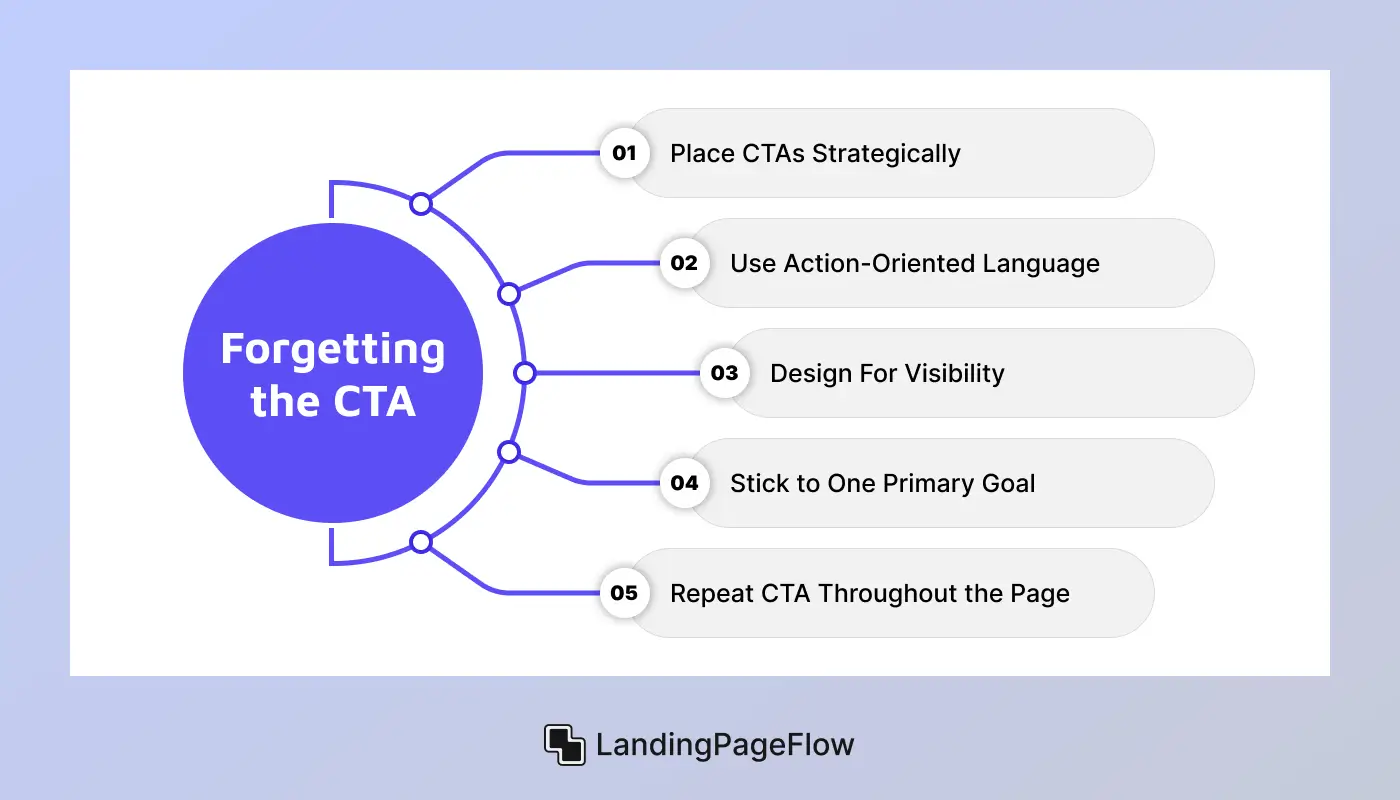
How to Fix This Landing Page Mistake
A powerful CTA guides users, anchors your conversion goal, and boosts landing page effectiveness.
Here's how to ensure your CTAs always count:
1. Place CTAs Strategically
Include a clear, clickable CTA in the hero section, mid-page, and at the end for visibility across scroll depth.
2. Use Action-Oriented Language
Write CTAs that clearly state the benefit or outcome, like “Start Free Trial,” “Download Guide,” or “Book My Demo.”
3. Design For Visibility
Make buttons stand out with contrasting colors, bold fonts, and white space around them.
4. Stick to One Primary Goal
Avoid confusing users with multiple conflicting CTAs. Guide them toward one focused conversion action.
5. Repeat CTA Throughout the Page
Reinforce the main CTA at natural stopping points to increase engagement and reduce bounce risk.
9. Poor Mobile Experience
In 2025, over half of your landing page traffic will likely come from mobile devices. Yet many brands still neglect mobile optimization, resulting in slow load times, broken layouts, and clumsy navigation that frustrate users and drive them away.
You might hear things like:
“It looks fine on desktop, so it should work on mobile too.”
“Most of our testing happens on larger screens.”
Who told you mobile users will tolerate a bad layout? The truth is, poor mobile experience damages conversion rates, hurts your search engine ranking, and alienates on-the-go visitors who expect seamless performance.
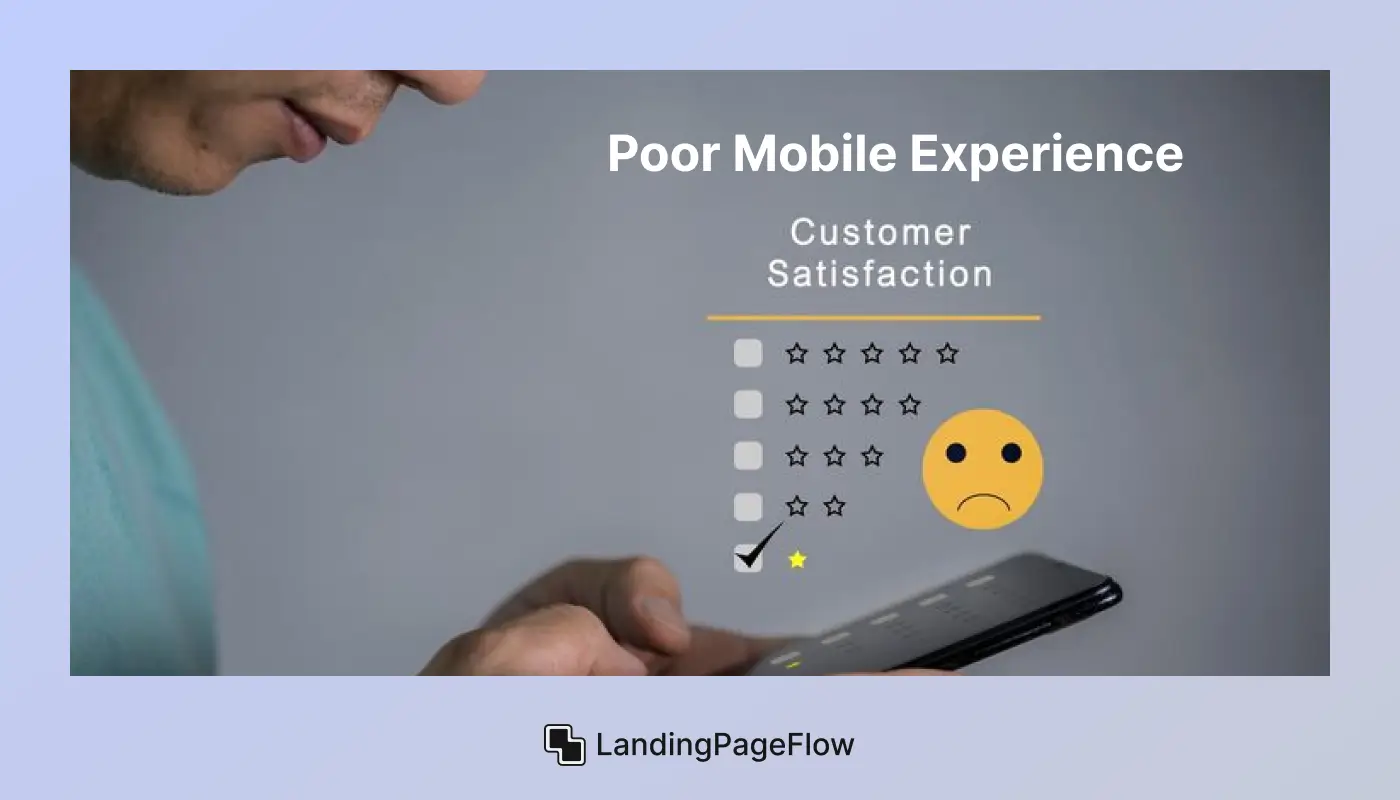
How to Fix This Landing Page Mistake
Optimizing for mobile should be a priority from the start, not an afterthought.
Here's how to ensure your mobile landing page performs:
1. Use Mobile-First Design Principles
Design layouts that scale up, not down. Keep content minimal, readable, and touch-friendly.
2. Optimize For Speed
Compress images, reduce scripts, and prioritize loading essentials first to meet Core Web Vitals on mobile networks.
3. Make CTAs Easy to Tap
Buttons should be large, spaced out, and thumb-friendly for quick access without accidental clicks.
4. Test Across Devices
Use tools like Google Mobile-Friendly Test or BrowserStack to preview performance on real devices and screen sizes.
5. Avoid Heavy Popups
Mobile users dislike intrusive modals. Keep overlays lightweight or timed gently to avoid blocking content.
10. Headline–Content Mismatch
Your headline makes a promise. If the content that follows doesn’t deliver, users bounce fast. A headline–content mismatch breaks trust, weakens your message, and leads to high drop-off rates.
You might hear things like:
“Our headline is catchy, that’s enough.”
“The details will explain it later.”
Who told you a catchy headline can carry the page alone? In truth, when your headline misleads, users feel tricked. If the offer or benefit isn’t clear or relevant to the headline, they’ll leave before reading further.
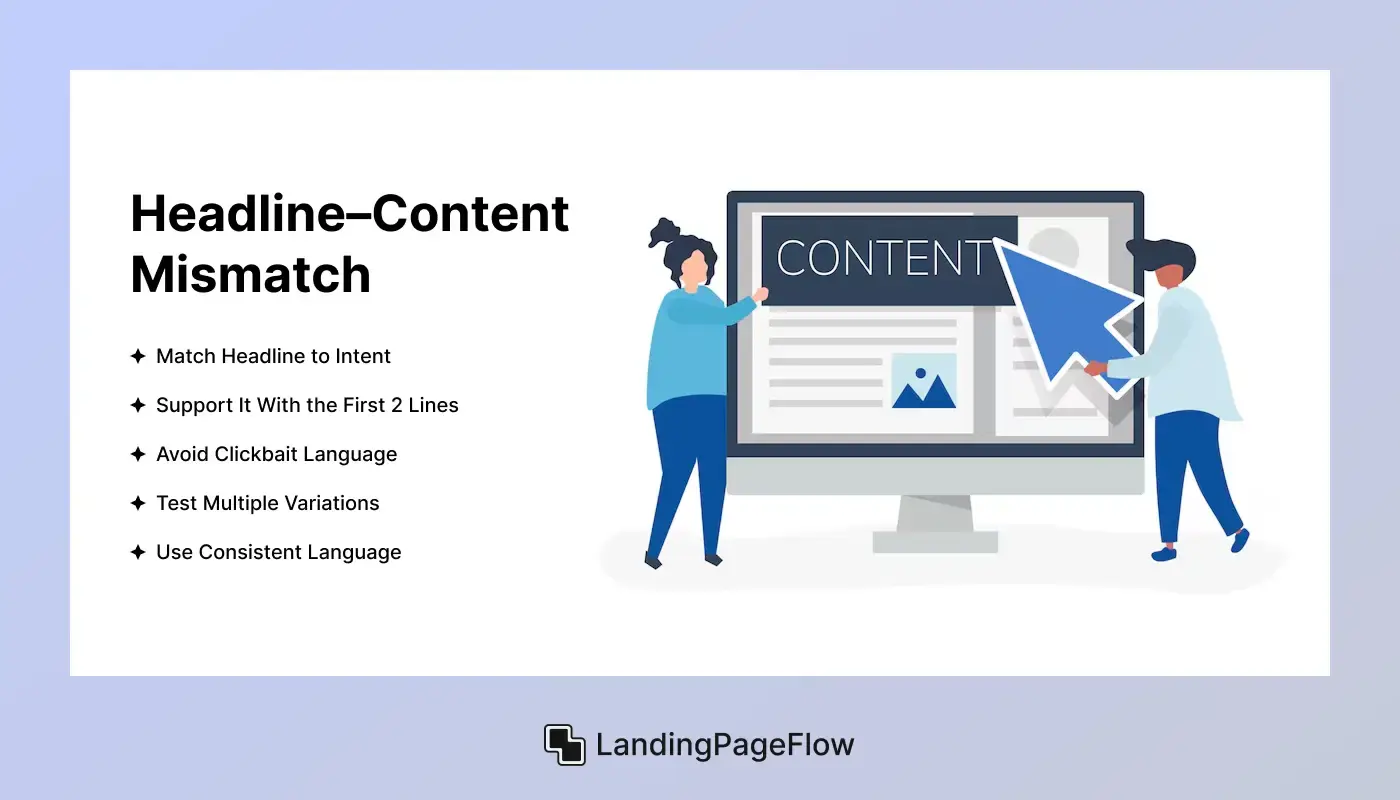
How to Fix This Landing Page Mistake
For your headline and content to work together, they must build on the same promise.
Here’s how to align them for stronger engagement and conversion:
1. Match Headline to Intent
Your headline should preview the exact value or benefit the visitor will get from the rest of the page.
2. Support It With the First 2 Lines
Make sure your intro immediately reinforces the headline’s claim, solving a specific pain point or need.
3. Avoid Clickbait Language
Sensational or vague headlines that don’t match the content increase bounce rate and reduce trust.
4. Test Multiple Variations
Run A/B tests on headlines and intros together, not in isolation. Optimize based on scroll depth and time on page.
5. Use Consistent Language
Mirror keywords from your headline in the body copy. This consistency reassures users they’re in the right place.
5. How to Test and Optimize Your Landing Page Copy?
Landing page success in 2025 depends heavily on how well your copy resonates with the audience and guides them to action. A visually appealing page still underperforms if the messaging isn’t clear, relevant, or persuasive. This is where strategic copy testing makes a difference.
Start by understanding that no landing page copy is ever truly “finished.” What worked last quarter might underperform today. The best brands continually analyze performance, experiment with copy, and refine based on data, not gut feeling.
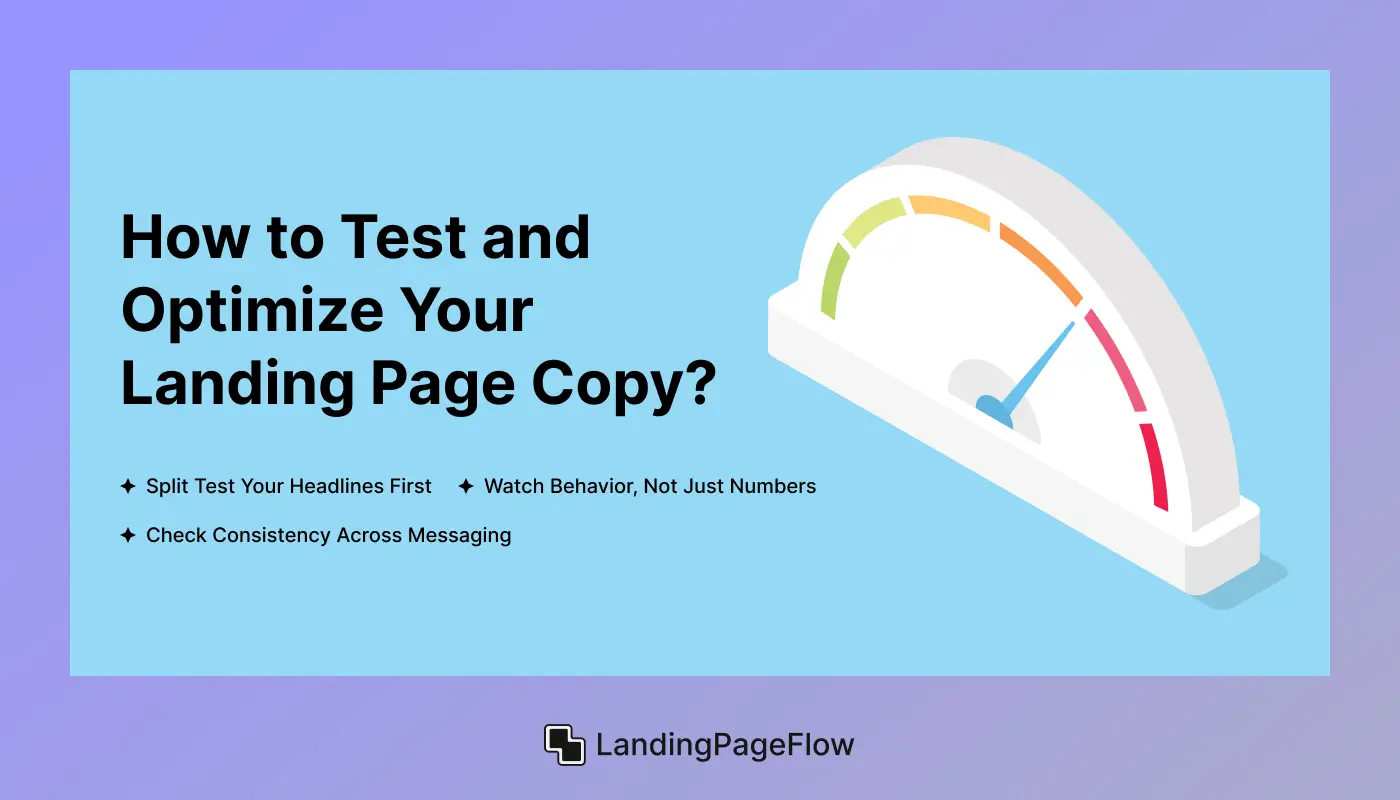
Core Techniques to Improve Copy Performance
1. Split Test Your Headlines First
The headline is your hook. Test versions that highlight emotional triggers, immediate value, or pain-point relief.
2. Watch Behavior, Not Just Numbers
Use scroll maps and session replays to see where users pause, click, or drop off. Poor engagement often points to confusing or bloated copy.
3. Revise Based on User Feedback
Gather comments through surveys or feedback widgets. If multiple users say, “I didn’t get it,” your copy needs reworking.
4. Experiment With CTA Tone
A small change like “Start Now” vs “See It in Action” can dramatically shift click-throughs. Align CTA copy with the tone of your offer.
5. Cycle Through Long vs. Short Copy
Some audiences convert better with concise lines, others want context and detail. Test different lengths to match your visitors' intent.
6. Check Consistency Across Messaging
Make sure your ad copy, headline, body content, and CTA feel like one narrative. Mismatched messages cause friction.
7. Monitor Metrics Beyond Conversions
Time on page, bounce rate, and scroll depth tell the real story behind how your copy performs, especially across devices.
Conclusion
Great design draws users in, but powerful copy is what makes them stay, trust, and take action. In 2025, landing page success isn’t just about having the right words, and it’s about saying the right thing at the right moment for the right visitor.
From slow-loading lines to unclear CTAs, even a small copy misstep can cost you valuable conversions. But the good news? Every mistake you fix creates a smoother path to more signups, downloads, and purchases.
If you're aiming to build landing pages that drive results, your copy needs to be clear, tested, audience-focused, and backed by intent, not guesswork. Each section should have a purpose. Every word should move users closer to “yes.”

FAQ
1. What’s the biggest copywriting mistake on landing pages in 2025?
The most common mistake is using vague, generic copy that fails to address the visitor’s pain point or intent. Users need clarity and value upfront to stay engaged.
2. How can I tell if my landing page copy is working?
Watch your bounce rate, scroll depth, and conversion metrics. If users don’t scroll or act, it’s a sign your messaging isn’t resonating.
3. Should my landing page copy be long or short?
It depends on your audience and offer. Test both. Complex products may need more explanation, while simple offers convert better with concise copy.
4. How important is the headline on a landing page?
Your headline is the first impression; it must grab attention and match user intent. A strong headline increases scroll rate and time on page significantly.
5. Can I use the same copy across all landing pages?
No. Copy should be tailored to each audience segment, campaign goal, or traffic source. One-size-fits-all messaging rarely converts well.
6. What tools help improve landing page copywriting?
Use A/B testing tools like Google Optimize or VWO, heatmaps like Hotjar, and writing assistants like Grammarly to refine clarity and structure.
















